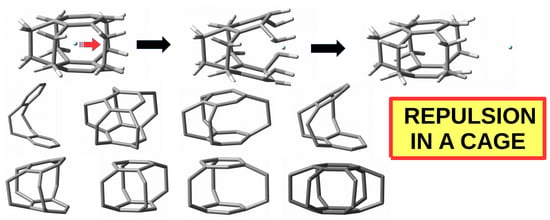Determining Repulsion in Cyclophane Cages
Abstract
:1. Introduction
2. Methodology
3. Results and Discussion
3.1. Experimental vs. Theoretical Structure of the Superphane Molecule
3.2. Ng@superphane Complexes
3.3. Opening the Cage
3.4. Mayer Bond Order
4. Conclusions
Funding
Data Availability Statement
Conflicts of Interest
Abbreviations
| Ng | noble gas |
| QTAIM | Quantum Theory of Atoms in Molecules |
| BP | bond path |
| BCP | bond critical point |
| MBO | Mayer Bond Order |
| RMS | root mean square |
References
- Bader, R.F.W. Atoms in Molecules: A Quantum Theory; Oxford University Press: New York, NY, USA, 1990. [Google Scholar]
- Popelier, P.L.A. Atoms in Molecules. An Introduction; Longman: Singapore, 2000. [Google Scholar]
- Matta, C.F.; Boyd, R.J. The Quantum Theory of Atoms in Molecules; Wiley-VCH: Weinheim, Germany, 2007. [Google Scholar]
- Bader, R.F.W. A Bond Path: A Universal Indicator of Bonded Interactions. J. Phys. Chem. A 1998, 102, 7314–7323. [Google Scholar] [CrossRef]
- Bader, R.F.W. A Quantum Theory of Molecular Structure and Its Appllcatlons. Chem. Rev. 1991, 91, 893–928. [Google Scholar] [CrossRef]
- Cioslowski, J.; Mixon, S.T.; Edwards, W.D. Weak Bonds in the Topological Theory of Atoms in Molecules. J. Am. Chem. Soc. 1991, 113, 1083–1085. [Google Scholar] [CrossRef]
- Cioslowski, J.; Mixon, S.T. Topological Properties of Electron Density in Search of Steric Interactions in Molecules: Electronic Structure Calculations on Ortho-Substituted Biphenyls. J. Am. Chem. Soc. 1992, 114, 4382–4387. [Google Scholar] [CrossRef]
- Cioslowski, J.; Mixon, S.T. Universality among topological properties of electron density associated with the hydrogen–hydrogen nonbonding interactions. Can. J. Chem. 1992, 70, 443–449. [Google Scholar] [CrossRef]
- Cioslowski, J.; Edgington, L.; Stefanov, B.B. Steric Overcrowding in Perhalogenated Cyclohexanes, Dodecahedranes, and [60]Fulleranes. J. Am. Chem. Soc. 1995, 117, 10381–10384. [Google Scholar] [CrossRef]
- Moran, D.; Woodcock, H.L.; Chen, Z.; Schaefer, H.F., III; Schleyer, P.v.R. On the Viability of Small Endohedral Hydrocarbon Cage Complexes: X@C4H4, X@C8H8, X@C8H14, X@C10H16, X@C12H12, and X@C16H16. J. Am. Chem. Soc. 2003, 125, 11442–11451. [Google Scholar] [CrossRef]
- Haaland, A.; Shorokhov, D.J.; Tverdova, N.V. Topological Analysis of Electron Densities: Is the Presence of an Atomic Interaction Line in an Equilibrium Geometry a Sufficient Condition for the Existence of a Chemical Bond? Chem. Eur. J. 2004, 10, 4416–4421. [Google Scholar] [CrossRef]
- Strenalyuk, T.; Haaland, A. Chemical Bonding in the Inclusion Complex of He in Adamantane (He@adam): The Origin of the Barrier to Dissociation. Chem. Eur. J. 2008, 14, 10223–10226. [Google Scholar] [CrossRef]
- Cerpa, E.; Krapp, A.; Vela, A.; Merino, G. The Implications of Symmetry of the External Potential on Bond Paths. Chem. Eur. J. 2008, 14, 10232–10234. [Google Scholar] [CrossRef]
- Cerpa, E.; Krapp, A.; Flores-Moreno, R.; Donald, K.J.; Merino, G. Influence of Endohedral Confinement on the Electronic Interaction between He atoms: A He2@C20H20 Case Study. Chem. Eur. J. 2009, 15, 1985–1990. [Google Scholar] [CrossRef]
- Jabłoński, M. Bond Paths between Distant Atoms Do Not Necessarily Indicate Dominant Interactions. J. Comput. Chem. 2018, 39, 2183–2195. [Google Scholar] [CrossRef] [PubMed]
- Jabłoński, M. On the Uselessness of Bond Paths Linking Distant Atoms and on the Violation of the Concept of Privileged Exchange Channels. ChemistryOpen 2019, 8, 497–507. [Google Scholar] [CrossRef] [PubMed]
- Jabłoński, M. Counterintuitive bond paths: An intriguing case of the ion. Chem. Phys. Lett. 2020, 759, 137946. [Google Scholar] [CrossRef]
- Jabłoński, M. Does the Presence of a Bond Path Really Mean Interatomic Stabilization? The Case of the Ng@Superphane (Ng = He, Ne, Ar, and Kr) Endohedral Complexes. Symmetry 2021, 13, 2241. [Google Scholar] [CrossRef]
- Jabłoński, M. Endo- and exohedral complexes of superphane with cations. J. Comput. Chem. 2022, 43, 1120–1133. [Google Scholar] [CrossRef]
- Jabłoński, M. The physical nature of the ultrashort spike–ring interaction in iron maiden molecules. J. Comput. Chem. 2022, 43, 1206–1220. [Google Scholar] [CrossRef]
- Tsirelson, V.G.; Zou, P.F.; Tang, T.-H.; Bader, R.F.W. Topological Definition of Crystal Structure: Determination of the Bonded Interactions in Solid Molecular Chlorine. Acta Cryst. 1995, A51, 143–153. [Google Scholar] [CrossRef]
- Bone, R.G.A.; Bader, R.F.W. Identifying and Analyzing Intermolecular Bonding Interactions in van der Waals Molecules. J. Phys. Chem. 1996, 100, 10892–10911. [Google Scholar] [CrossRef]
- Abramov, Y.A. Secondary Interactions and Bond Critical Points in Ionic Crystals. J. Phys. Chem. A 1997, 101, 5725–5728. [Google Scholar] [CrossRef]
- Vila, A.; Mosquera, R.A. On the perfluorination of alkyl ethers. An electron density study under the AIM approach. J. Mol. Struct. (Theochem) 2001, 546, 63–72. [Google Scholar] [CrossRef]
- Luaña, V.; Costales, A.; Mori-Sánchez, P.; Pendás, A.M. Ions in Crystals: The Topology of the Electron Density in Ionic Materials. 4. The Danburite (CaB2Si2O8) Case and the Occurrence of Oxide–Oxide Bond Paths in Crystals. J. Phys. Chem. B 2003, 107, 4912–4921. [Google Scholar] [CrossRef]
- Matta, C.F.; Castillo, N.; Boyd, R.J. Characterization of a Closed-Shell Fluorine–Fluorine Bonding Interaction in Aromatic Compounds on the Basis of the Electron Density. J. Phys. Chem. A 2005, 109, 3669–3681. [Google Scholar] [CrossRef] [PubMed]
- Pakiari, A.H.; Eskandari, K. Closed shell oxygen–oxygen bonding interaction based on electron density analysis. J. Mol. Struct. Theochem 2007, 806, 1–7. [Google Scholar] [CrossRef]
- Palusiak, M.; Grabowski, S.J. Do intramolecular halogen bonds exist? Ab initio calculations and crystal structures’ evidences. Struct. Chem. 2007, 18, 859–865. [Google Scholar] [CrossRef]
- Jabłoński, M. Energetic and Geometrical Evidence of Nonbonding Character of Some Intramolecular Halogen⋯Oxygen and Other Y⋯Y Interactions. J. Phys. Chem. A 2012, 116, 3753–3764. [Google Scholar] [CrossRef]
- Jabłoński, M.; Palusiak, M. The halogen⋯oxygen interaction in 3-halogenopropenal revisited – The dimer model vs. QTAIM indications. Chem. Phys. 2013, 415, 207–213. [Google Scholar] [CrossRef]
- Dem’yanov, P.; Polestshuk, P. A Bond Path and an Attractive Ehrenfest Force Do Not Necessarily Indicate Bonding Interactions: Case Study on M2X2 (M = Li, Na, K; X = H, OH, F, Cl). Chem. Eur. J. 2012, 18, 4982–4993. [Google Scholar] [CrossRef]
- Tognetti, V.; Joubert, L. On the physical role of exchange in the formation of an intramolecular bond path between two electronegative atoms. J. Chem. Phys. 2013, 138, 024102. [Google Scholar] [CrossRef]
- Tognetti, V.; Joubert, L. On critical points and exchange-related properties of intramolecular bonds between two electronegative atoms. Chem. Phys. Lett. 2013, 579, 122–126. [Google Scholar] [CrossRef]
- Jabłoński, M. Hydride-Triel Bonds. J. Comput. Chem. 2018, 39, 1177–1191. [Google Scholar] [CrossRef] [PubMed]
- Matta, C.F.; Hernández-Trujillo, J.; Tang, T.-H.; Bader, R.F.W. Hydrogen-Hydrogen Bonding: A Stabilizing Interaction in Molecules and Crystals. Chem. Eur. J. 2003, 9, 1940–1951. [Google Scholar] [CrossRef] [PubMed]
- Poater, J.; Solà, M.; Bickelhaupt, F.M. Hydrogen–Hydrogen Bonding in Planar Biphenyl, Predicted by Atoms-in-Molecules Theory, Does Not Exist. Chem. Eur. J. 2006, 12, 2889–2895. [Google Scholar] [CrossRef] [PubMed]
- Poater, J.; Solà, M.; Bickelhaupt, F.M. A Model of the Chemical Bond Must Be Rooted in Quantum Mechanics, Provide Insight, and Possess Predictive Power. Chem. Eur. J. 2006, 12, 2902–2905. [Google Scholar] [CrossRef]
- Dillen, J. Congested Molecules. Where is the Steric Repulsion? An Analysis of the Electron Density by the Method of Interacting Quantum Atoms. Int. J. Quantum Chem. 2013, 113, 2143–2153. [Google Scholar] [CrossRef]
- Keyvani, Z.A.; Shahbazian, S.; Zahedi, M. To What Extent are “Atoms in Molecules” Structures of Hydrocarbons Reproducible from the Promolecule Electron Densities? Chem. Eur. J. 2016, 22, 5003–5009. [Google Scholar] [CrossRef]
- Darzynkiewicz, R.B.; Scuseria, G.E. Noble Gas Endohedral Complexes of C60 Buckminsterfullerene. J. Phys. Chem. A 1997, 101, 7141–7144. [Google Scholar] [CrossRef]
- Sekine, Y.; Brown, M.; Boekelheide, V. [2.2.2.2.2.2](l,2,3,4,5,6)Cyclophane: Superphane. J. Am. Chem. Soc. 1979, 101, 3126–3127. [Google Scholar] [CrossRef]
- Hanson, A.W.; Cameron, T.S. Crystal structures of, and strain in, some adjacent-bridged [2n]cyclophanes. J. Chem. Res. Synop. 1980, 10, 336–337. [Google Scholar]
- Sekine, Y.; Boekelheide, V. A Study of the Synthesis and Properties of [26](1,2,3,4,5,6)Cyclophane (Superphane). J. Am. Chem. Soc. 1981, 103, 1777–1785. [Google Scholar] [CrossRef]
- Available online: https://en.wikipedia.org/wiki/Superphane (accessed on 15 June 2022).
- Schreiner, P.R.; Chernish, L.V.; Gunchenko, P.A.; Tikhonchuk, E.Y.; Hausmann, H.; Serafin, M.; Schlecht, S.; Dahl, J.E.P.; Carlson, R.M.K.; Fokin, A.A. Overcoming lability of extremely long alkane carbon–carbon bonds through dispersion forces. Nature 2011, 477, 308–311. [Google Scholar] [CrossRef] [PubMed]
- Fokin, A.A.; Chernish, L.V.; Gunchenko, P.A.; Tikhonchuk, E.Y.; Hausmann, H.; Serafin, M.; Dahl, J.E.P.; Carlson, R.M.K.; Schreiner, P.R. Stable Alkanes Containing Very Long Carbon–Carbon Bonds. J. Am. Chem. Soc. 2012, 134, 13641–13650. [Google Scholar] [CrossRef] [PubMed]
- Ishigaki, Y.; Shimajiri, T.; Takeda, T.; Katoono, R.; Suzuki, T. Longest C–C Single Bond among Neutral Hydrocarbons with a Bond Length beyond 1.8 Å. Chem 2018, 4, 795–806. [Google Scholar] [CrossRef] [Green Version]
- Brown, D.A.; Clegg, W.; Colquhoun, H.M.; Daniels, J.A.; Stephenson, I.R.; Wade, K. A pentuply-bridging carbonyl group: Crystal and molecular structure of a salt of the 1-oxo-2-phenyl-1,2-dicarbadodecaborate(12) anion, [LH]+[O(Ph)C2B10H10]− (L = 1,8-N,N,N’,N’-tetramethylnaphthalenediamine). J. Chem. Soc. Chem. Commun. 1987, 889–891. [Google Scholar] [CrossRef]
- Llop, J.; Viñas, C.; Teixidor, F.; Victori, L.; Kivekäs, R.; Sillanpää, R. Redox Potential Modulation in Mixed Sandwich Pyrrolyl/Dicarbollide Complexes. Inorg. Chem. 2002, 41, 3347–3352. [Google Scholar] [CrossRef]
- Li, J.; Pang, R.; Li, Z.; Lai, G.; Xiao, X.-Q.; Müller, T. Exceptionally Long C–C Single Bonds in Diamino-o-carborane as Induced by Negative Hyperconjugation. Angew. Chem. Int. Ed. 2019, 58, 1397–1401. [Google Scholar] [CrossRef]
- Novoa, J.J.; Lafuente, P.; Del Sesto, R.E.; Miller, J.S. Exceptionally Long (≥2.9 Å) C–C Bonds between [TCNE]− Ions: Two-Electron, Four-Center π⋆-π⋆ C–C Bonding in . Angew. Chem. Int. Ed. 2001, 40, 2540–2545. [Google Scholar] [CrossRef]
- Novoa, J.J.; Stephens, P.W.; Weerasekare, M.; Shum, W.W.; Miller, J.S. The Tetracyanopyrazinide Dimer Dianion, 2-Electron 8-Center Bonding. J. Am. Chem. Soc. 2009, 131, 9070–9075. [Google Scholar] [CrossRef]
- Mayer, I. Charge, bond order and valence in the AB initio SCF theory. Chem. Phys. Lett. 1983, 97, 270–274. [Google Scholar] [CrossRef]
- Mayer, I. Bond order and valence: Relations to Mulliken’s population analysis. Int. J. Quantum Chem. 1984, 26, 151–154. [Google Scholar] [CrossRef]
- Mayer, I. Bond Order and Valence Indices: A Personal Account. J. Comput. Chem. 2007, 28, 204–221. [Google Scholar] [CrossRef]
- Bridgeman, A.J.; Cavigliasso, G.; Ireland, L.R.; Rothery, J. The Mayer bond order as a tool in inorganic chemistry. J. Chem. Soc. Dalton Trans. 2001, 2095–2108. [Google Scholar] [CrossRef]
- Gleiter, R.; Hopf, H. (Eds.) Modern Cyclophane Chemistry; Wiley-VCH: Weinheim, Germany, 2004. [Google Scholar]
- Caramori, G.F.; Galembeck, S.E.; Laali, K.K. A Computational Study of [2.2]Cyclophanes. J. Org. Chem. 2005, 70, 3242–3250. [Google Scholar] [CrossRef]
- Caramori, G.F.; Galembeck, S.E. Computational Study about Through-Bond and Through-Space Interactions in [2.2]Cyclophanes. J. Phys. Chem. A 2007, 111, 1705–1712. [Google Scholar] [CrossRef] [PubMed]
- Dodziuk, H.; Szymański, S.; Jaźwiński, J.; Ostrowski, M.; Demissie, T.B.; Ruud, K.; Kuś, P.; Hopf, H.; Lin, S.-T. Structure and NMR Spectra of Some [2.2]Paracyclophanes. The Dilemma of [2.2]Paracyclophane Symmetry. J. Phys. Chem. A 2011, 115, 10638–10649. [Google Scholar] [CrossRef]
- Misturini, A.; Ortolan, A.O.; Caramori, G.F.; Cintra, C.H.; Parreira, R.L.T. Tracking the absence of anion–π interactions in modified [23](1,3,5)cyclophanes: Insights from computation. New J. Chem. 2019, 43, 13271–13281. [Google Scholar] [CrossRef]
- Galembeck, S.E.; Caramori, G.F.; Misturini, A.; Garcia, L.C.; Orenha, R.P. Metal–Ligand Bonding Situation in Ruthenophanes Containing Multibridged Cyclophanes. Organometallics 2017, 36, 3465–3470. [Google Scholar] [CrossRef]
- Mardirossian, N.; Head-Gordon, M. Thirty years of density functional theory in computational chemistry: An overview and extensive assessment of 200 density functionals. Mol. Phys. 2017, 115, 2315–2372. [Google Scholar] [CrossRef]
- Hohenberg, P.; Kohn, W. Inhomogeneous Electron Gas. Phys. Rev. 1964, 136, B864–B871. [Google Scholar] [CrossRef] [Green Version]
- Parr, R.G.; Yang, W. Density-Functional Theory of Atoms and Molecules; Oxford University Press: New York, NY, USA, 1989. [Google Scholar]
- Becke, A.D. Density-functional exchange-energy approximation with correct asymptotic behavior. Phys. Rev. A 1988, 38, 3098–3100. [Google Scholar] [CrossRef]
- Becke, A.D. Density-functional thermochemistry. III. The role of exact exchange. J. Chem. Phys. 1993, 98, 5648–5652. [Google Scholar] [CrossRef] [Green Version]
- Lee, C.; Yang, W.; Parr, R.G. Development of the Colle-Salvetti correlation-energy formula into a functional of the electron density. Phys. Rev. B 1988, 37, 785–789. [Google Scholar] [CrossRef] [PubMed] [Green Version]
- Grimme, S.; Antony, J.; Ehrlich, S.; Krieg, H. A consistent and accurate ab initio parametrization of density functional dispersion correction (DFT-D) for the 94 elements H-Pu. J. Chem. Phys. 2010, 132, 154104. [Google Scholar] [CrossRef] [PubMed] [Green Version]
- Grimme, S.; Ehrlich, S.; Goerigk, L. Effect of the Damping Function in Dispersion Corrected Density Functional Theory. J. Comput. Chem. 2011, 32, 1456–1465. [Google Scholar] [CrossRef] [PubMed]
- Perdew, J.P.; Chevary, J.A.; Vosko, S.H.; Jackson, K.A.; Pederson, M.R.; Singh, D.J.; Fiolhais, C. Atoms, molecules, solids, and surfaces: Applications of the generalized gradient approximation for exchange and correlation. Phys. Rev. B 1993, 46, 6671–6687. [Google Scholar] [CrossRef]
- Tao, J.; Perdew, J.P.; Staroverov, V.N.; Scuseria, G.E. Climbing the Density Functional Ladder: Nonempirical Meta–Generalized Gradient Approximation Designed for Molecules and Solids. Phys. Rev. Lett. 2003, 91, 146401. [Google Scholar] [CrossRef] [Green Version]
- Staroverov, V.N.; Scuseria, G.E.; Tao, J.; Perdew, J.P. Comparative assessment of a new nonempirical density functional: Molecules and hydrogen-bonded complexes. J. Chem. Phys. 2003, 119, 12129–12137. [Google Scholar] [CrossRef]
- Zhao, Y.; Truhlar, D.G. A new local density functional for main-group thermochemistry, transition metal bonding, thermochemical kinetics, and noncovalent interactions. J. Chem. Phys. 2006, 125, 194101. [Google Scholar] [CrossRef] [Green Version]
- Zhao, Y.; Truhlar, D.G. The M06 suite of density functionals for main group thermochemistry, thermochemical kinetics, noncovalent interactions, excited states, and transition elements: Two new functionals and systematic testing of four M06-class functionals and 12 other functionals. Theor. Chem. Acc. 2008, 120, 215–241. [Google Scholar]
- Zhao, Y.; Truhlar, D.G. Density Functional for Spectroscopy: No Long-Range Self-Interaction Error, Good Performance for Rydberg and Charge-Transfer States, and Better Performance on Average than B3LYP for Ground States. J. Phys. Chem. A 2006, 110, 13126–13130. [Google Scholar] [CrossRef]
- Perdew, J.P.; Burke, K.; Ernzerhof, M. Generalized Gradient Approximation Made Simple. Phys. Rev. Lett. 1996, 77, 3865–3868. [Google Scholar] [CrossRef] [Green Version]
- Adamo, C.; Barone, V. Toward reliable density functional methods without adjustable parameters: The PBE0 model. J. Chem. Phys. 1999, 110, 6158–6170. [Google Scholar] [CrossRef]
- Chai, J.-D.; Head-Gordon, M. Long-range corrected hybrid density functionals with damped atom–atom dispersion corrections. Phys. Chem. Chem. Phys. 2008, 10, 6615–6620. [Google Scholar] [CrossRef] [Green Version]
- Szabo, A.; Ostlund, N.S. Modern Quantum Chemistry: Introduction to Advanced Electronic Structure Theory; Dover Publications, Inc.: New York, NY, USA, 1982. [Google Scholar]
- Pritchard, B.P.; Altarawy, D.; Didier, B.; Gibson, T.D.; Windus, T.L. New Basis Set Exchange: An Open, Up-to-Date Resource for the Molecular Sciences Community. J. Chem. Inf. Model. 2019, 59, 4814–4820. [Google Scholar] [CrossRef]
- Frisch, M.J.; Trucks, G.W.; Schlegel, H.B.; Scuseria, G.E.; Robb, M.A.; Cheeseman, J.R.; Scalmani, G.; Barone, V.; Petersson, G.A.; Nakatsuji, H.; et al. Gaussian 16, Revision C.01; Gaussian, Inc.: Wallingford, CT, USA, 2019. [Google Scholar]
- Boys, S.F.; Bernardi, F. The calculation of small molecular interactions by the differences of separate total energies. Some procedures with reduced errors. Mol. Phys. 1970, 19, 553–566. [Google Scholar] [CrossRef]
- Pauling, L. The Nature of the Chemical Bond; Cornell University Press: New York, NY, USA, 1960. [Google Scholar]
- Schuster, P.; Zundel, G.; Sandorfy, C. (Eds.) The Hydrogen Bond. Recent Developments in Theory and Experiments; North Holland: Amsterdam, The Netherlands, 1976. [Google Scholar]
- Jeffrey, G.A. An Introduction to Hydrogen Bonding; Oxford University Press: New York, NY, USA, 1997. [Google Scholar]
- Grabowski, S.J. Hydrogen Bonding–New Insights. Challenges and Advances in Computational Chemistry and Physics; Springer: Dordrecht, The Netherlands, 2006. [Google Scholar]
- Gilli, G.; Gilli, P. The Nature of the Hydrogen Bond. Outline of a Comprehensive Hydrogen Bond Theory; Oxford University Press: Oxford, UK, 2009. [Google Scholar]
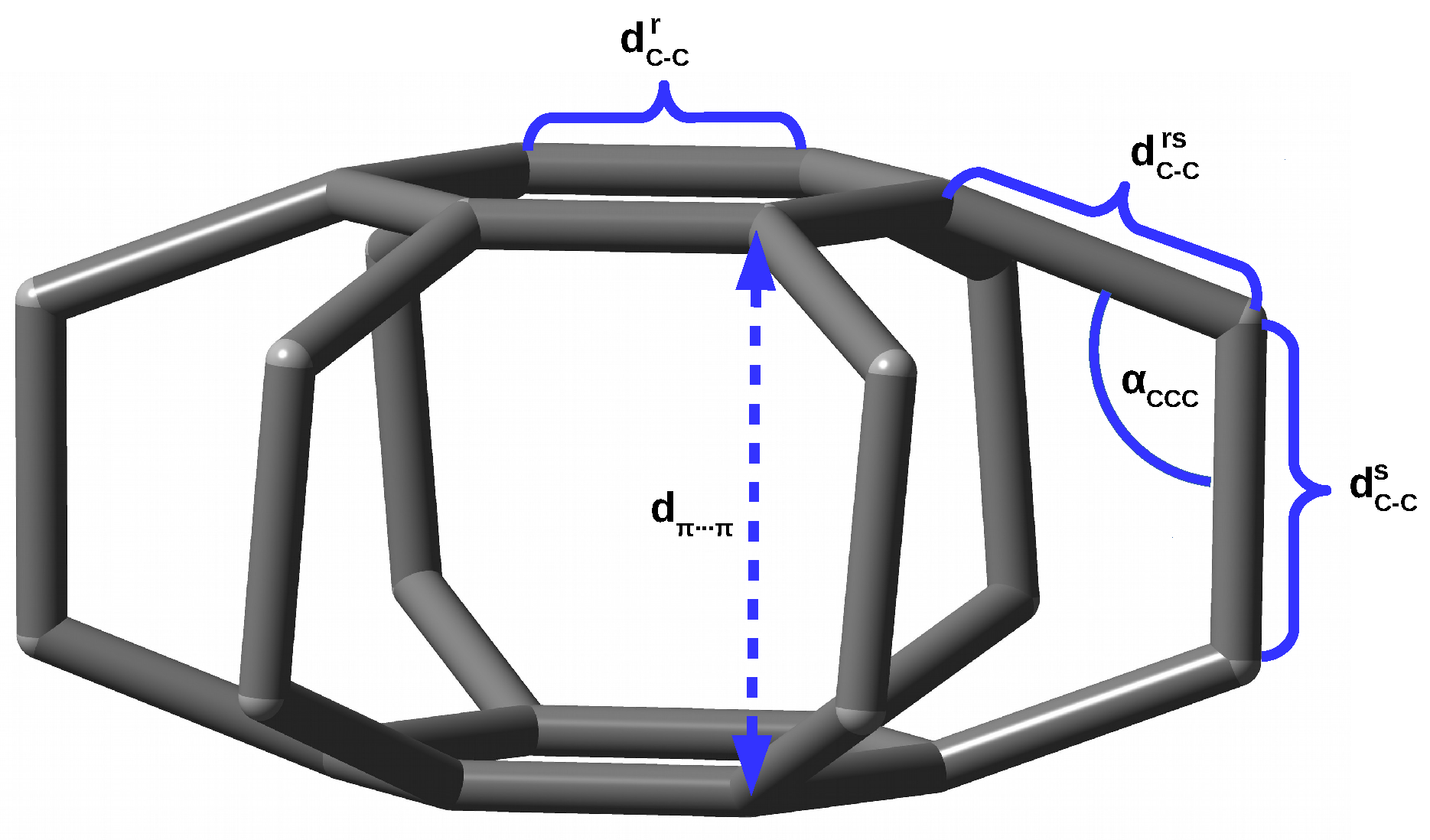

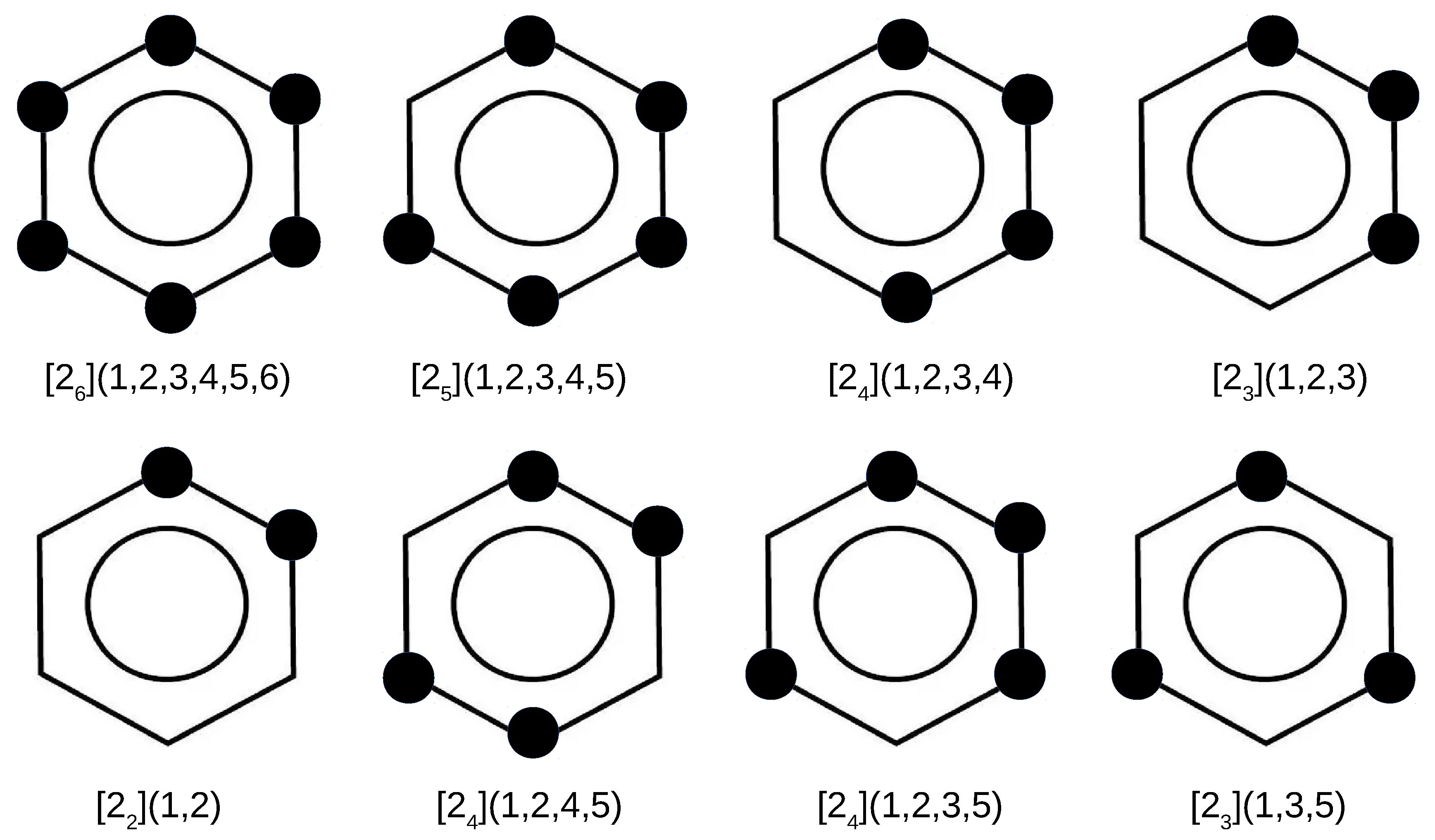
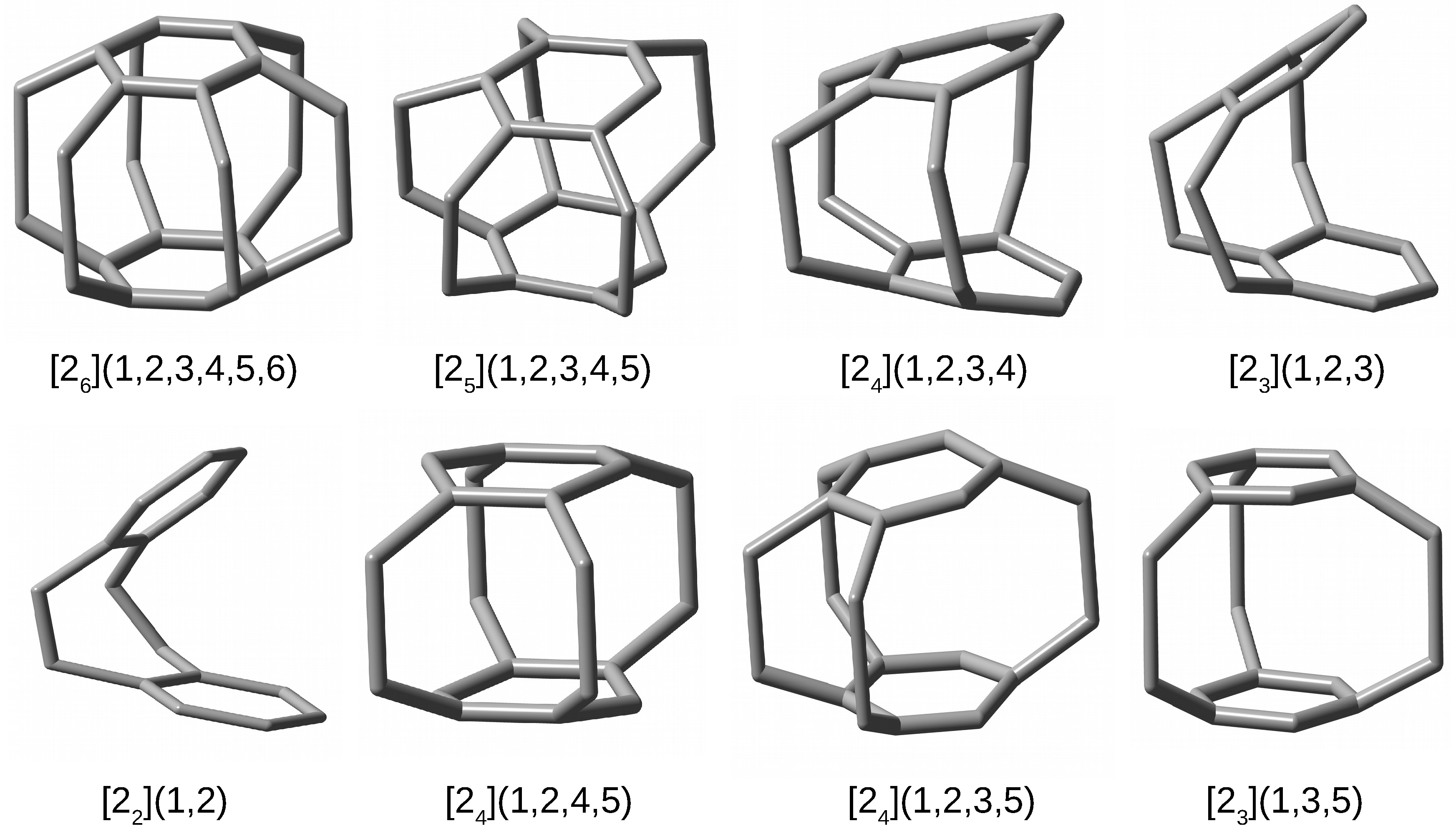
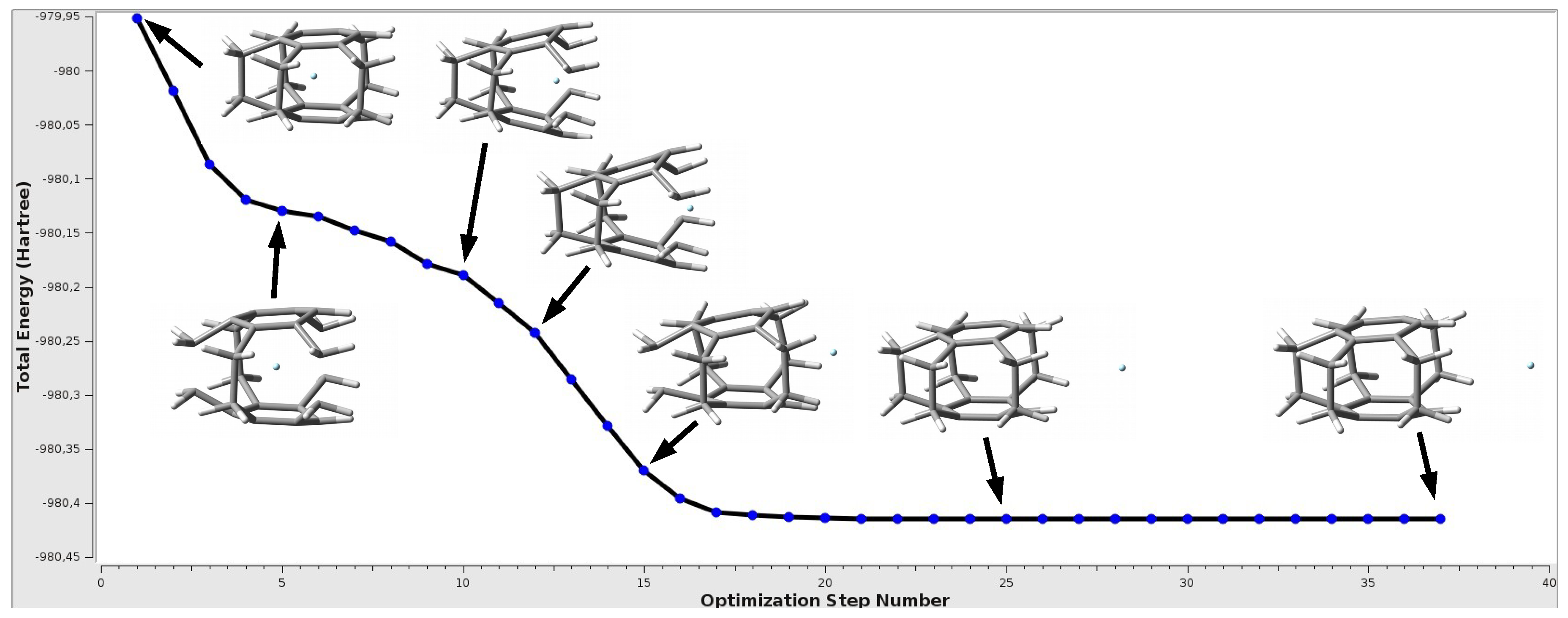

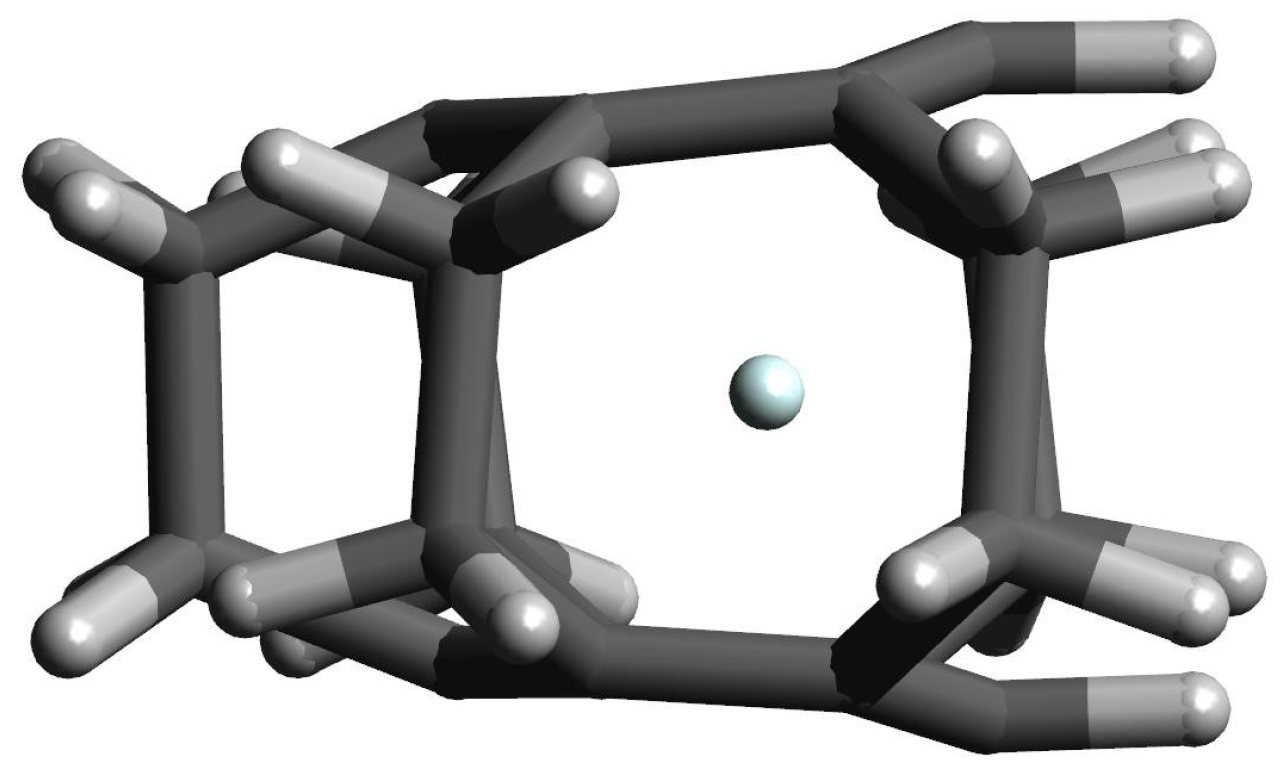

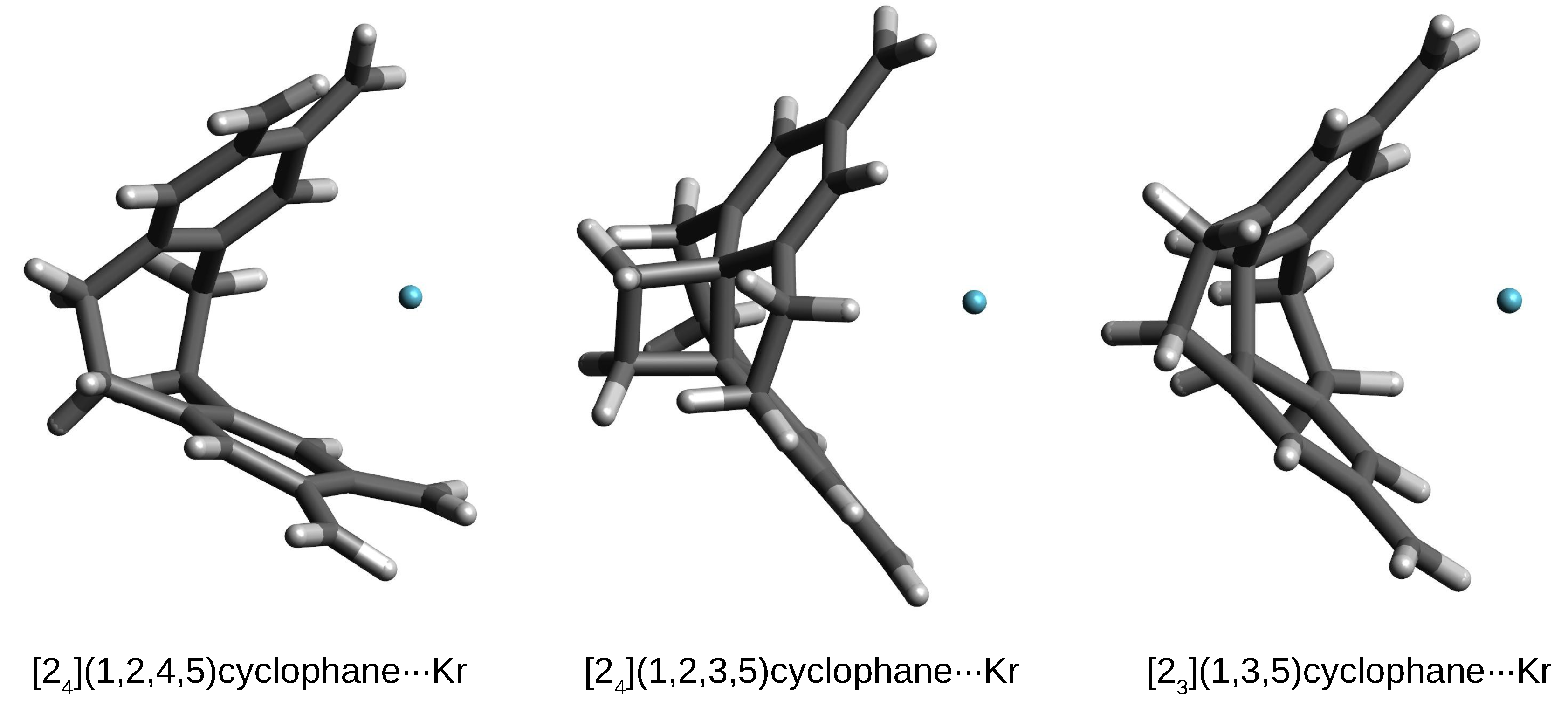
| Method | Symm. | RMS (Bonds) | ||||||
|---|---|---|---|---|---|---|---|---|
| exp. [42] | a | 2.624 b | 1.406 c | 1.580 d | 1.518 e | 110.1 f | 0.2 g | n/a |
| HF | 2.662 | 1.401 | 1.594 | 1.525 | 110.5 | 0.0 | 0.010 | |
| 2.663 | 1.401 | 1.593 | 1.526 | 110.4 | 6.1 | 0.009 | ||
| B3LYP | 2.661 | 1.412 | 1.605 | 1.522 | 110.3 | 0.0 | 0.015 | |
| B3LYP-D3 | 2.663 | 1.412 | 1.605 | 1.522 | 110.3 | 0.0 | 0.015 | |
| 2.665 | 1.412 | 1.605 | 1.552 | 110.4 | 3.6 | 0.015 | ||
| B3PW91 | 2.639 | 1.409 | 1.595 | 1.515 | 110.1 | 0.0 | 0.009 | |
| 2.641 | 1.409 | 1.594 | 1.516 | 110.1 | 5.3 | 0.009 | ||
| B3PW91-D3 | 2.642 | 1.409 | 1.595 | 1.515 | 110.2 | 0.0 | 0.009 | |
| 2.645 | 1.409 | 1.594 | 1.516 | 110.2 | 6.8 | 0.008 | ||
| TPSSh | 2.640 | 1.412 | 1.604 | 1.519 | 109.9 | 0.0 | 0.014 | |
| 2.643 | 1.412 | 1.602 | 1.520 | 109.9 | 8.1 | 0.013 | ||
| M06-L | 2.646 | 1.409 | 1.591 | 1.513 | 110.4 | 0.0 | 0.008 | |
| 2.650 | 1.409 | 1.587 | 1.515 | 110.2 | 11.4 | 0.005 | ||
| M06 | 2.641 | 1.406 | 1.589 | 1.512 | 110.4 | 0.0 | 0.006 | |
| 2.642 | 1.406 | 1.587 | 1.513 | 110.3 | 5.7 | 0.005 | ||
| M06-HF | 2.642 | 1.404 | 1.602 | 1.523 | 109.9 | 0.0 | 0.013 | |
| 2.645 | 1.404 | 1.598 | 1.525 | 109.7 | 12.3 | 0.011 | ||
| M06-2X | 2.653 | 1.408 | 1.596 | 1.520 | 110.4 | 0.0 | 0.009 | |
| 2.657 | 1.407 | 1.592 | 1.521 | 110.2 | 11.5 | 0.007 | ||
| PBE0 | 2.632 | 1.407 | 1.591 | 1.513 | 110.1 | 0.0 | 0.007 | |
| 2.635 | 1.407 | 1.589 | 1.513 | 110.1 | 7.5 | 0.006 | ||
| B97X-D | 2.651 | 1.406 | 1.594 | 1.519 | 110.4 | 0.0 | 0.008 | |
| 2.653 | 1.406 | 1.592 | 1.519 | 110.3 | 6.7 | 0.007 |
| Ng | |||||||||
|---|---|---|---|---|---|---|---|---|---|
| ∅ | n/a | n/a | n/a | n/a | 2.653 | 1.592 | 1.406 | 110.3 | 6.7 |
| He | 72.8 | 80.7 | 8.5 | 10.5 | 2.819 | 1.601 | 1.417 | 113.3 | 8.1 |
| Ne | 145.1 | 202.1 | 59.5 | 29.4 | 3.130 | 1.630 | 1.431 | 118.8 | 9.7 |
| Ar | 251.9 | 438.4 | 187.6 | 42.8 | 3.568 | 1.707 | 1.447 | 126.1 | 8.8 |
| Kr | 311.3 | 551.5 | 241.7 | 43.8 | 3.703 | 1.753 | 1.434 | 127.9 | 3.2 |
| 1.481 | 5.0 |
| Cyclophane | Ng | a | a | a | a | a | |||
|---|---|---|---|---|---|---|---|---|---|
| [2](1,2,3,4,5) | ∅ | n/a | n/a | n/a | 2.628–3.012 | 1.582–1.603 | 1.391–1.409 | 110.0–112.1 | 5.9–6.1 |
| He | 59.0 | 69.7 | 11.0 | 2.758–3.458 | 1.584–1.627 | 1.402–1.414 | 112.3–116.7 | 8.6–9.6 | |
| Ne | −0.5 | −1.0 | 0.0 | 2.628–3.014 | 1.582–1.603 | 1.391–1.409 | 110.0–112.2 | 5.9–6.2 | |
| Ar | −1.1 | −1.3 | 0.0 | 2.628–3.015 | 1.582–1.603 | 1.391–1.409 | 110.0–112.2 | 5.7–5.8 | |
| Kr | −1.7 | −1.9 | 0.0 | 2.628–3.017 | 1.582–1.603 | 1.391–1.410 | 110.0–112.2 | 5.5–5.6 | |
| [2](1,2,3,4) | ∅ | n/a | n/a | n/a | 2.617–3.479 | 1.577–1.594 | 1.384–1.410 | 109.7–113.4 | 9.6–11.1 |
| He | −0.2 | −0.2 | 0.0 | 2.617–3.478 | 1.577–1.594 | 1.384–1.410 | 109.7–113.4 | 9.5–11.1 | |
| Ne | −0.5 | −0.9 | 0.0 | 2.617–3.478 | 1.577–1.594 | 1.384–1.410 | 109.7–113.4 | 9.8–11.3 | |
| Ar | −1.1 | −1.2 | 0.0 | 2.617–3.483 | 1.577–1.594 | 1.384–1.410 | 109.7–113.4 | 9.7–11.3 | |
| Kr | −1.6 | −1.8 | 0.0 | 2.617–3.486 | 1.577–1.594 | 1.384–1.410 | 109.7–113.4 | 9.6–11.3 | |
| [2](1,2,3) | ∅ | n/a | n/a | n/a | 2.595–4.470 | 1.555–1.585 | 1.388–1.404 | 109.6–114.9 | 14.6–18.0 |
| He | −0.2 | −0.2 | 0.0 | 2.594–4.464 | 1.555–1.585 | 1.388–1.404 | 109.6–114.8 | 14.4–17.8 | |
| Ne | −0.5 | −0.9 | 0.0 | 2.594–4.469 | 1.555–1.585 | 1.388–1.404 | 109.6–114.9 | 14.4–17.9 | |
| Ar | −1.0 | −1.2 | 0.0 | 2.594–4.481 | 1.555–1.585 | 1.388–1.404 | 109.6–114.9 | 14.3–17.9 | |
| Kr | −1.6 | −1.8 | 0.0 | 2.594–4.496 | 1.555–1.585 | 1.388–1.404 | 109.7–114.9 | 14.4–18.0 | |
| [2](1,2) | ∅ | n/a | n/a | n/a | 2.926–5.586 | 1.553 | 1.388–1.403 | 113.1–116.9 | 31.4 |
| He | −0.2 | −0.2 | 0.0 | 2.933–5.627 | 1.553 | 1.388–1.403 | 113.2–117.1 | 31.8 | |
| Ne | −0.5 | −1.0 | 0.0 | 2.943–5.689 | 1.553 | 1.387–1.403 | 113.4–117.2 | 32.2 | |
| Ar | −1.4 | −1.5 | 0.1 | 2.965–5.821 | 1.551 | 1.387–1.403 | 113.7–117.6 | 33.5 | |
| Kr | −2.3 | −2.3 | 0.3 | 2.987–5.941 | 1.550 | 1.387–1.403 | 114.0–117.9 | 34.8 |
| Cyclophane | Ng | a | a | a | a | a | |||
|---|---|---|---|---|---|---|---|---|---|
| [2](1,2,4,5) | ∅ | n/a | n/a | n/a | 2.713–2.982 | 1.594 | 1.394–1.400 | 111.7 | 0.0 |
| He | 56.0 | 65.0 | 9.4 | 2.916–3.267 | 1.604 | 1.402–1.408 | 115.2–115,4 | 11.2 | |
| Ne | −0.5 | −0.9 | 0.0 | 2.713–2.984 | 1.594 | 1.394–1.400 | 111.7 | 0.0 | |
| Ar | −1.9 | 51.4 | 53.6 | 2.927–5.644 | 1.554 | 1.344–1.485 | 113.1–117.5 | 29.6 | |
| Kr | −3.0 | 50.3 | 53.7 | 2.940–5.722 | 1.553 | 1.344–1.485 | 113.3–117.8 | 30.2 | |
| [2](1,2,3,5) | ∅ | n/a | n/a | n/a | 2.612–2.917 | 1.577–1.610 | 1.391–1.405 | 110.0–113.0 | 0.0 |
| He | 55.8 | 65.7 | 10.3 | 2.738–3.241 | 1.577–1.641 | 1.401–1.412 | 112.3–118.0 | 8.9–10.8 | |
| Ne | −0.5 | −1.0 | 0.0 | 2.612–2.916 | 1.578–1.612 | 1.391–1.405 | 110.0–113.0 | 0.3 | |
| Ar | −2.0 | 26.6 | 28.9 | 1.609–6.036 | 1.540–1.546 | 1.336–1.504 | 90.9–113.9 | 9.6–26.1 | |
| Kr | −3.2 | 25.4 | 28.9 | 1.609–6.058 | 1.540–1.545 | 1.336–1.504 | 90.9–113.9 | 9.6–26.4 | |
| [2](1,3,5) | ∅ | n/a | n/a | n/a | 2.773–2.858 | 1.611 | 1.394 | 112.6 | 0.0 |
| He | 54.2 | 63.5 | 9.7 | 2.990–3.124 | 1.628 | 1.402 | 116.5 | 9.0 | |
| Ne | −0.5 | −0.9 | 0.0 | 2.772–2.857 | 1.613 | 1.394 | 112.6 | 0.2–0.3 | |
| Ar b | −1.0 | −1.1 | 0.0 | 2.772–2.857 | 1.613 | 1.394 | 112.6 | 0.0 | |
| Ar b | −1.9 | 14.9 | 17.1 | 1.587–5.748 | 1.546 | 1.334–1.507 | 109.0–112.4 | 29.3 | |
| Kr | −3.0 | 13.9 | 17.1 | 1.587–5.775 | 1.545 | 1.334–1.507 | 109.0–112.4 | 29.8 |
Publisher’s Note: MDPI stays neutral with regard to jurisdictional claims in published maps and institutional affiliations. |
© 2022 by the author. Licensee MDPI, Basel, Switzerland. This article is an open access article distributed under the terms and conditions of the Creative Commons Attribution (CC BY) license (https://creativecommons.org/licenses/by/4.0/).
Share and Cite
Jabłoński, M. Determining Repulsion in Cyclophane Cages. Molecules 2022, 27, 3969. https://doi.org/10.3390/molecules27133969
Jabłoński M. Determining Repulsion in Cyclophane Cages. Molecules. 2022; 27(13):3969. https://doi.org/10.3390/molecules27133969
Chicago/Turabian StyleJabłoński, Mirosław. 2022. "Determining Repulsion in Cyclophane Cages" Molecules 27, no. 13: 3969. https://doi.org/10.3390/molecules27133969
APA StyleJabłoński, M. (2022). Determining Repulsion in Cyclophane Cages. Molecules, 27(13), 3969. https://doi.org/10.3390/molecules27133969





